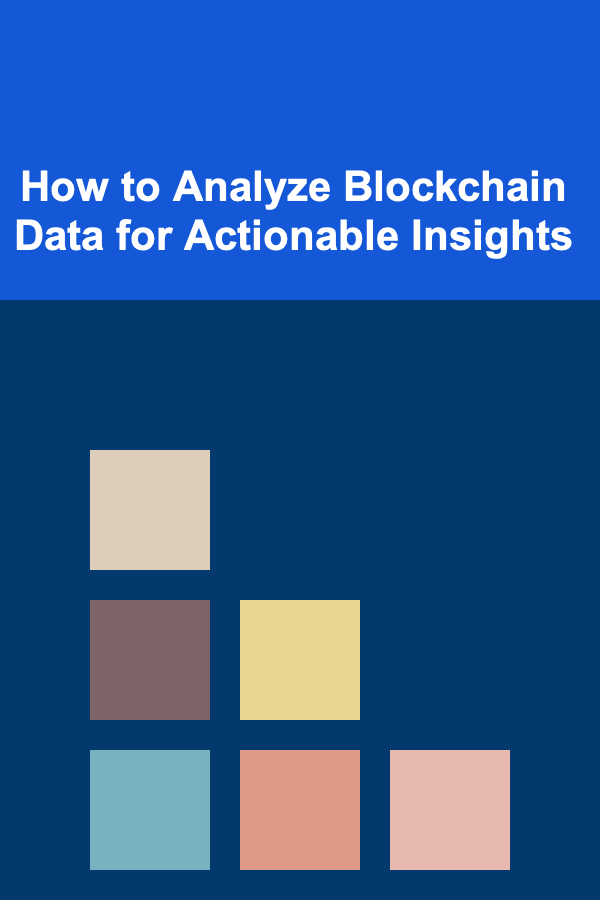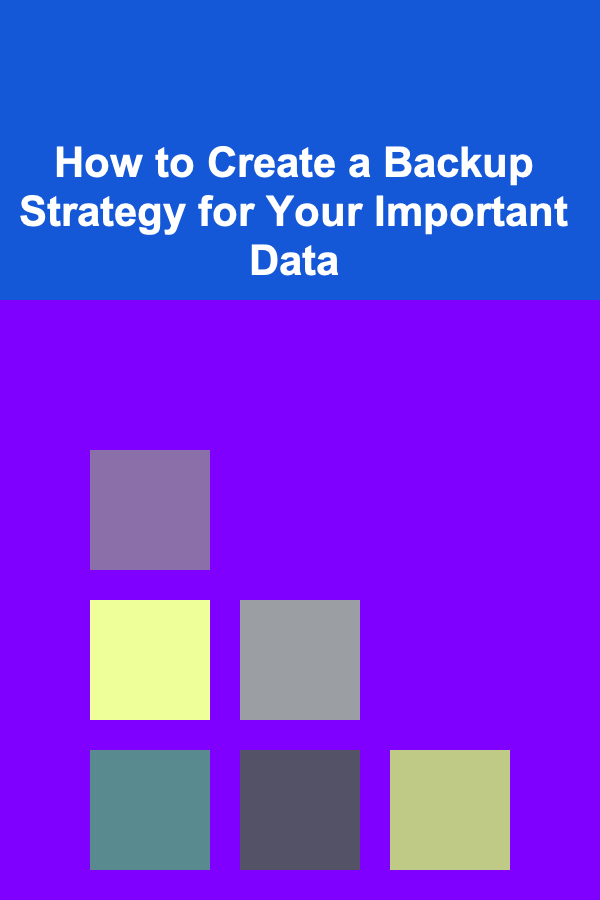
How to Analyze Blockchain Data for Actionable Insights
ebook include PDF & Audio bundle (Micro Guide)
$12.99$6.99
Limited Time Offer! Order within the next:

Blockchain technology, originally created as the foundation for cryptocurrencies like Bitcoin, has evolved far beyond its initial scope. Today, it is used across various industries, from supply chain management to healthcare, finance, and even digital voting systems. However, as blockchain applications continue to expand, so does the need for efficient analysis of blockchain data to uncover valuable insights. This article explores how to analyze blockchain data, methods to interpret the data, and how actionable insights can be derived for real-world applications.
Understanding Blockchain Data
Before delving into the analysis of blockchain data, it is crucial to first understand the type of data stored on a blockchain and how it is structured. Blockchains are distributed, decentralized ledgers that maintain a record of transactions. Each block in a blockchain contains data that is cryptographically linked to the previous block, forming an immutable chain of records. Here's an overview of the components of blockchain data:
- Transactions: Each block contains multiple transactions, with each transaction representing a transfer of assets or information between participants. These transactions include details such as the sender, receiver, amount, timestamp, and any additional data relevant to the blockchain's application (e.g., smart contract interactions in Ethereum).
- Block Information: A block in a blockchain contains metadata like the block hash, timestamp, and the hash of the previous block, ensuring the chain's integrity. Additionally, blocks may contain information about the miner or validator who added the block to the chain.
- Smart Contracts: In blockchains like Ethereum, smart contracts are self-executing contracts with the terms of the agreement directly written into code. Analyzing smart contract data involves interpreting contract events, function calls, and state changes.
- Token Data: Many blockchains, particularly Ethereum, use tokens as digital assets. Analyzing token transfers and contract interactions can reveal important trends in the market or community activity.
- Network Statistics: Blockchain networks generate a plethora of statistical data, including transaction volume, block propagation times, network hash rate, and more. These metrics are crucial for understanding the overall health and performance of the blockchain network.
- Addresses and Wallet Data: A critical component of blockchain analysis is examining wallet addresses, especially when looking for activity patterns such as large transfers, whale movements, or clustering of addresses belonging to the same entity.
Why Analyze Blockchain Data?
Blockchain data analysis can provide valuable insights in several ways:
- Transaction Monitoring: Blockchain is transparent, meaning that every transaction is visible to all participants. Analyzing this data can help detect suspicious or illicit activities such as fraud, money laundering, or other illegal transactions.
- Market Insights: By analyzing token transfers, market trends, and liquidity on decentralized exchanges (DEXs), analysts can gain a better understanding of market conditions, investor sentiment, and asset performance.
- Network Health and Optimization: By monitoring blockchain's performance metrics such as block times, transaction throughput, and network congestion, stakeholders can assess the efficiency of the network, identify bottlenecks, and plan optimizations.
- Smart Contract Interactions: By studying the execution of smart contracts, analysts can detect inefficiencies, vulnerabilities, or unexpected behaviors in decentralized applications (dApps), which can help improve contract design or security.
- Regulatory Compliance: Blockchain data analysis can help regulators and auditors ensure compliance with financial regulations by tracking transactions, identifying patterns, and confirming that entities adhere to laws such as Anti-Money Laundering (AML) and Know Your Customer (KYC) standards.
- Supply Chain and Logistics: Blockchain's immutable and transparent nature makes it ideal for tracking goods and services in a supply chain. By analyzing blockchain data, companies can gain visibility into the movement of goods, verify the authenticity of products, and reduce fraud.
Tools and Techniques for Blockchain Data Analysis
The tools and methods used for blockchain data analysis depend on the blockchain protocol and the type of data being analyzed. Below are some essential tools and techniques:
1. Blockchain Explorers
Blockchain explorers are one of the simplest and most widely used tools for viewing transaction and block data on a public blockchain. Explorers like Etherscan (for Ethereum), Blockchain.com (for Bitcoin), and others allow users to inspect transactions, blocks, smart contracts, token transfers, and addresses.
Key Features of Blockchain Explorers:
- Transaction Search: Users can search for specific transactions using transaction IDs (TXIDs) to see transaction details such as the amount, fees, and addresses involved.
- Block Information: Each block's contents, including the timestamp, miner, and transaction data, are accessible for detailed analysis.
- Address Tracking: Blockchain explorers enable tracking of wallet addresses, which can provide insights into wallet activity, token holdings, and transaction history.
2. Data Aggregation and Visualization Tools
To analyze large amounts of blockchain data and extract actionable insights, aggregation and visualization tools are necessary. These tools typically pull data from blockchain explorers or full nodes and present it in a way that is easier to understand.
- Dune Analytics: Dune Analytics is a powerful tool that allows users to query blockchain data and create custom dashboards. It is widely used by analysts and researchers to explore blockchain data and derive insights for various protocols, especially for Ethereum-based projects.
- Glassnode: Glassnode offers on-chain analytics services, providing insights into blockchain data through a combination of charts, metrics, and visualizations. It is particularly useful for tracking metrics related to Bitcoin and Ethereum networks.
- Nansen: Nansen is an analytics platform that provides in-depth analytics for the Ethereum blockchain, focusing on wallet clusters, token movements, and on-chain behaviors.
3. Node Data and Full Nodes
For more advanced blockchain analysis, running a full node or using node data can provide access to raw, unfiltered blockchain data. Full nodes store the entire history of a blockchain and validate transactions and blocks. With access to a full node, analysts can:
- Query Raw Blockchain Data: Analysts can directly query a blockchain's state to gain deeper insights into historical data and identify complex patterns or correlations.
- Advanced Filtering: Using full nodes, analysts can apply custom filters to transaction data, which is crucial when analyzing large amounts of data from multiple sources.
4. On-Chain Analysis Tools
On-chain analysis tools allow you to examine blockchain data in more detail. These tools are specifically designed for in-depth analysis of transactions, addresses, and smart contracts. Popular on-chain analysis tools include:
- Chainalysis: Chainalysis is one of the leading on-chain analysis platforms. It is widely used by law enforcement and financial institutions for tracking illicit transactions and investigating cryptocurrency crimes.
- Crystal Blockchain: Crystal is an on-chain analysis tool that visualizes the flow of funds between blockchain addresses and provides detailed analysis of individual transactions.
5. Machine Learning and AI
As blockchain data grows in complexity and volume, machine learning (ML) and artificial intelligence (AI) are becoming indispensable for analyzing large datasets. AI can detect patterns in blockchain transactions that are not immediately apparent to human analysts. Key applications of AI in blockchain analysis include:
- Anomaly Detection: Using machine learning algorithms, analysts can detect unusual patterns in transaction data that could indicate fraud, hacks, or other malicious activities.
- Predictive Analytics: AI can predict market trends and asset performance by analyzing transaction volume, liquidity, and historical data.
- Cluster Analysis: AI algorithms can group related addresses, identifying clusters of activity that belong to the same entity, making it easier to track high-value transactions.
How to Derive Actionable Insights from Blockchain Data
Analyzing blockchain data is only the first step. To derive actionable insights, you need to interpret the data in a way that can drive decisions or actions. Here's how to go from analysis to actionable insights:
1. Identifying Transaction Patterns
One of the most common insights that can be gained from blockchain data is transaction patterns. By examining when and how transactions occur, analysts can uncover:
- Whale Activity: Large transactions, especially those that occur in bursts, often indicate whale movements. Monitoring whale activity can give insights into market sentiment or possible market manipulation.
- Frequent Small Transactions: A high frequency of small transactions could indicate growing user activity on a particular platform or ecosystem, signaling growth or increased interest in a project.
2. Monitoring Market Sentiment
Blockchain data can reveal valuable insights about market sentiment, especially by tracking token movements across wallets and exchanges. Analyzing token transfers between addresses and exchanges can help identify:
- Accumulation or Distribution: Patterns of token accumulation or distribution provide insights into investor sentiment. A sharp increase in accumulation may signal bullish behavior, while large-scale distribution could indicate a bearish trend.
- Network Growth: The growth in the number of wallet addresses interacting with a specific token or blockchain protocol may indicate increasing adoption and interest in the project.
3. Fraud Detection and Risk Management
Blockchain data analysis plays a significant role in identifying fraudulent activities, such as money laundering, Ponzi schemes, and other types of financial fraud. By tracking the flow of funds across addresses, analysts can identify suspicious patterns, including:
- High-frequency Transactions: Unusually high transaction frequencies from a particular address or group of addresses could signal fraudulent activity or an attempt to launder money.
- Linking Addresses to Known Actors: By using blockchain forensics tools, analysts can link suspicious addresses to known bad actors or illicit activities, enabling law enforcement and financial institutions to take preventive actions.
4. Performance Metrics and Optimization
Blockchain data analysis can also help assess the performance of a blockchain network and identify areas for optimization. Metrics such as transaction throughput, latency, and block times provide insights into the network's efficiency and health. If transaction times or block propagation times are too high, it might indicate issues with the network's scalability.
Conclusion
Blockchain data analysis is a powerful tool for extracting actionable insights from the decentralized and transparent world of blockchain. By leveraging blockchain explorers, data aggregation tools, machine learning, and advanced on-chain analysis, analysts can gain critical insights into market trends, transaction patterns, network performance, and even identify fraudulent activities.
The key to unlocking the true potential of blockchain data lies in using the right tools and methodologies to interpret the data and apply these insights to make informed decisions. As blockchain technology continues to evolve, the ability to analyze blockchain data effectively will become increasingly important across various sectors, from finance to supply chain management and beyond.

How to Build a Family Vision Board Together
Read More
How to Create a Backup Strategy for Your Important Data
Read More
How to Organize a Small Bedroom Without Feeling Cramped
Read More
What Steps Can You Take to Organize Your Pantry by Category?
Read More
How to Navigate the Bustling Markets of Marrakech
Read More
How to Cook African-Inspired Dishes
Read MoreOther Products

How to Build a Family Vision Board Together
Read More
How to Create a Backup Strategy for Your Important Data
Read More
How to Organize a Small Bedroom Without Feeling Cramped
Read More
What Steps Can You Take to Organize Your Pantry by Category?
Read More
How to Navigate the Bustling Markets of Marrakech
Read More